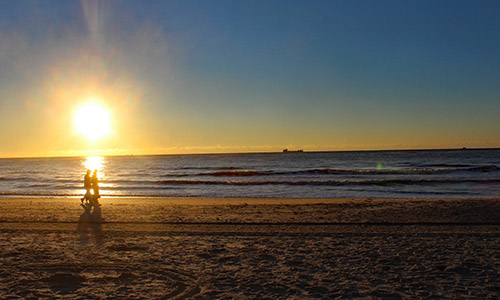
As a guest at The Breakers Resort, you are greeted with the sweeping views of the Atlantic Ocean in have one of the best locations in Myrtle Beach.
If you are wondering about the history and the first people that started shaping Myrtle Beach into what it is today, you will want to sit back and read how it all began.
The Myrtle Beach area was first known as Long Bay and was inhabited by the Waccamaw Indians. The area was quite different then and mostly the rivers were used to fish and travel along the shore around the Little River area. Waties Island, the primary barrier island along Long Bay, has evidence of burial and shell mounds, remains of the visiting Waccamaw Indians.
After the Indians the first settlers arrived in the late 17th century. They wanted to extend their land/plantations out to the ocean. However due to the non-ability to grow many crops due to the coastal soil and sand, it was hard for these settlers to live and grow. They mostly grew large quantities of indigo and tobacco, but the quality wasn’t up to par.
During the American Revolution era, most of the Long Bay region was uninhabited. However there were several families that lived along the coast due to land grants. One of those families were the Withers. The area where the Withers lived was where the Myrtle Swash, or the 8-mile Swash. Another grant was given to James Minor, a barrier island named Minor Island, now Waties Island, off of the coast near Little River.
As America reached independence, Horry County remained essentially unchanged, and the coast remained barren. George Washington scouted out the Southern states during his term, traveling down the King's Highway. He stayed the night at Windy Hill and was led across Wither's Swash to Georgetown by Jeremiah Vereen.
The Withers family remained one of the few settlers around Myrtle Beach for the next half-century. In 1822, a strong hurricane swept the house of R. F. Withers into the ocean, drowning 18 people inside. The tragedy made the Withers family decide to abandon their plots along the coast, and the area, left unattended, the area began to return to forest.
Following the Civil War, most of the abandoned land along the ocean was purchased by the Conway Lumber Company. The company built the Conway & Seashore Railroad to move chopped timber from the coast inland. A “Withers” post office was established at the site of the old Swash.
After the railroad was finished, employees of the lumber and railroad company would take train flatcars down to the beach on their weekends off, in essence becoming the first Grand Strand tourists. The area where the railroad ended was nicknamed “New Town”, contrasting it with the “Old Town”, or Conway.
In 1900, a hotel, the Seaside Inn, had been built by the company to handle visitors from the railroad. Around the same time, a contest was held to name New Town. F. G. Burroughs, a member of the Burroughs family, suggested honoring the local abundant shrub, and the area was named Myrtle Beach.
Myrtle Beach began as little more than a resort town for employees of the Conway Lumber Company, now Burroughs & Chapin. It continued to grow for the next couple of decades, and in 1938, it finally incorporated. In 1940, Myrtle Beach Municipal Airport was built, and Kings Highway was finally paved, giving Myrtle Beach its first primary highway.
So, as you take a walk along the beach or sitting on the balcony of the Breaker's Resort, think of yesteryear and what it might have been like and what it is like today.

